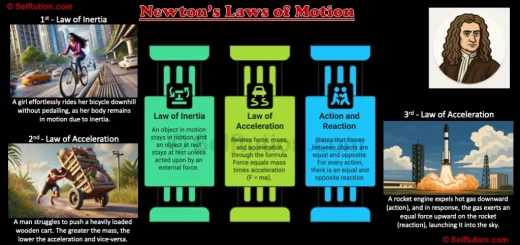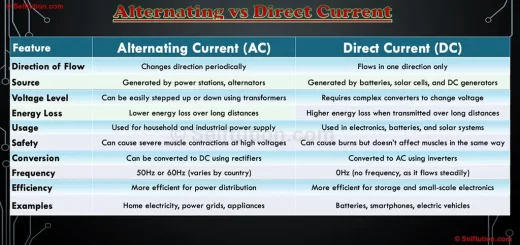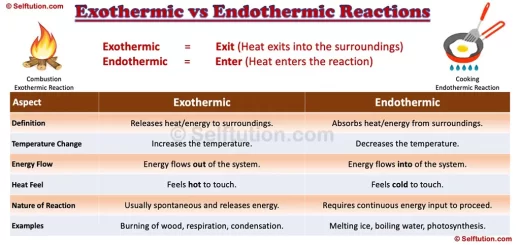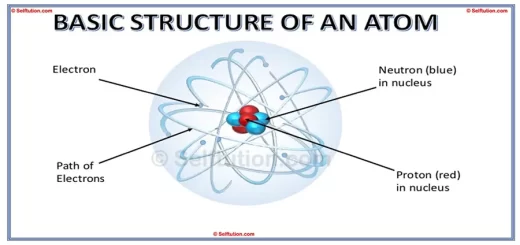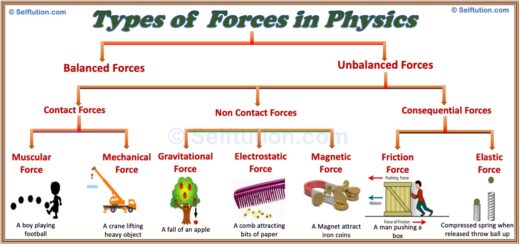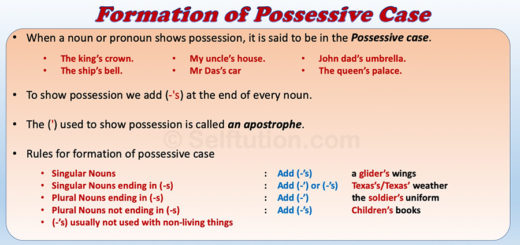Types of Forces in Physics with Examples
Force is the push or pull that makes something move, change direction, or bring it to rest. It can also speed up or slow down a moving body. There are various types of forces in physics, such as – biological or muscular forces, mechanical forces, gravitational forces, electrical or electrostatic forces, magnetic forces, frictional forces, elastic forces, etc.
Definition of Force
Force is an external agent which changes or tends to change the state of rest or uniform motion of a body or changes its direction or shape.
All forces in physics are categorized into two types – balanced and unbalanced forces. Balanced forces are those which fail to change a body’s state from rest to motion or motion to rest, whereas unbalanced forces are those, which bring a change in the form or the state of a body. It is an application of unbalanced force that changes the state from rest to motion or motion to rest or changes an object’s shape or size. Unbalanced forces are of three types – contact force, non-contact force (force at a distance), and consequential forces.
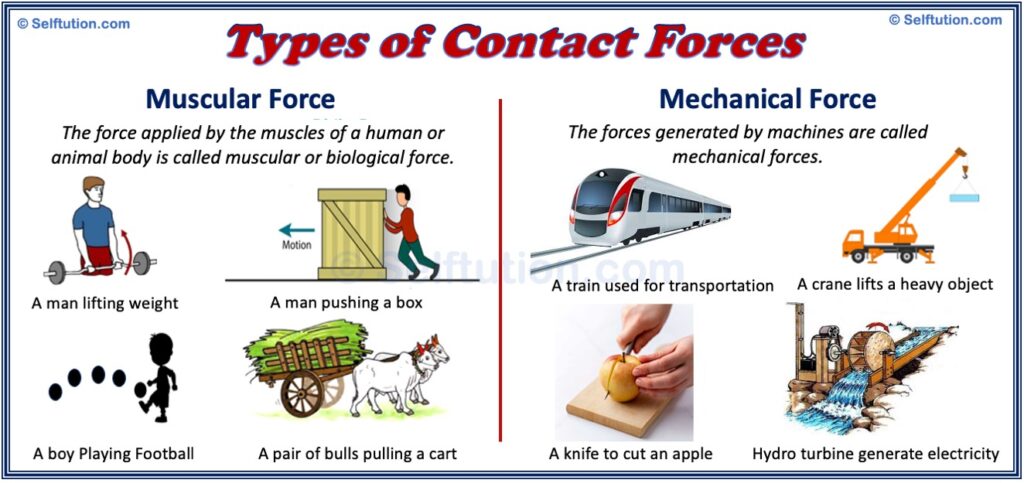
Types of Contact Forces with examples – muscular and mechanical force
CONTACT FORCE
Contact forces are those forces that act on a body directly or through a connector. When we apply these types of forces, then the object with which we apply the force and the object on which the force is applied is in direct contact. Some examples of these types of forces are – biological or muscular forces and mechanical forces.
Biological Forces or Muscular Forces
Al living beings need energy for living. We use this energy to apply force for doing various activities such as lifting, pushing, pulling, stretching, or compressing. We use our muscles to carry out these activities. Therefore, the force produced by the muscles of living beings is called muscular force or biological force.
Definition of Muscular or Biological Force
The force applied by the muscles of a human or animal body is called muscular or biological force.
For example, lifting of heavyweight, pulling a wheeled cart, pushing a lawn roller, stretching a chest expander, compressing a bale of cotton, etc., involves muscular forces. Some more examples of day-to-day usage of these types of forces are – walking, running, kicking, and lifting certain objects.
However, if the force required is too large and our body cannot produce it, we use the muscular force of animals. For example, we use bullocks to plow fields; horses for moving carriages; donkeys and camels for carrying heavy loads, and elephants for moving logs in jungles. Sometimes, we use non-living objects for performing certain jobs. For example, we use an ax for cutting wood, a knife for cutting fruits, vegetables, meat, etc., and a hammer for driving nails into the wall. In performing the above activities, we use our muscular or biological force.
Mechanical Forces
When we use machines to exert force, then we call it mechanical force. We can use mechanical force to change the state from rest to motion or motion to rest or brings a change in the shape or size of an object. A machine simply reduces the effort required to do the work.
Definition of Mechanical Force
The forces generated by machines are called mechanical forces.
For example, we use a knife to cut fruit and a pair of scissors to cut a piece of cloth. Here knife and a pair of scissors are simple machines. Similarly, the engine of a car exerts a mechanical force to move it and a railway engine exerts a force to pull the train. The force exerted by the wind moves a sailboat or rotates the windmill, it is the mechanical force.
A machine does not exert force by itself, but it needs energy, which it gets from other sources. Some examples of the types of energy used to produce different mechanical forces:
- We use the energy of petrol to produce the mechanical force to run a motor car.
- The force used to run a steam engine is produced by using the energy of coal.
- The wind turbines use the energy of wind to produce a force that is used for grinding wheat.
- Sailboats use the energy of wind to produce a force that moves the boat.
- The energy of flowing water runs a generator to produce an electric current.
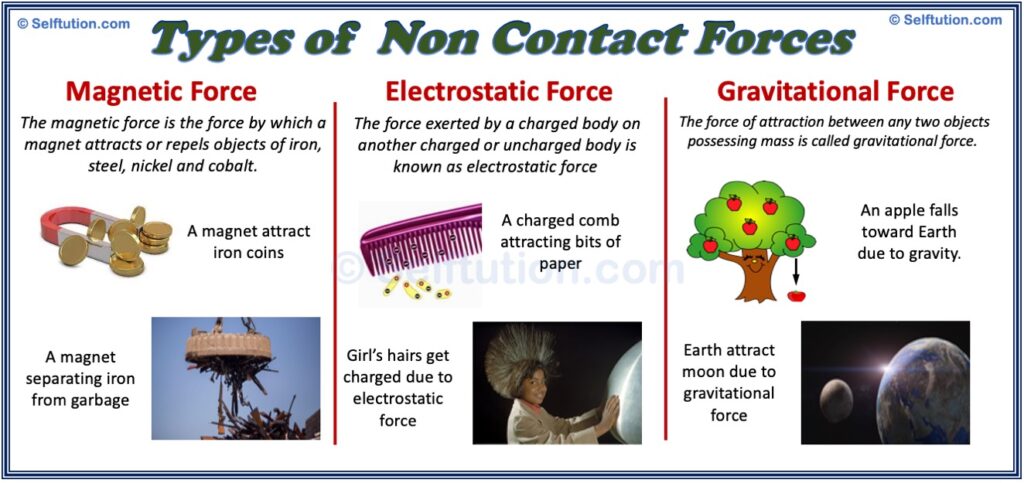
Types of non contact forces – mechanical, electrical, gravitational
NON CONTACT FORCE
Non Contact forces are those forces that do not make direct contact with a body. Here, we apply force on an object without actually making physical contact. These types of forces act through space from a distance, therefore we also call them forces at a distance. Examples of these types of forces are – gravitational forces, electrical or electrostatic forces, and magnetic forces.
Magnetic Forces
When we place substances like iron, steel, and cobalt in a coil carrying an electric current, they develop a strange property of attracting tiny bits of iron or steel toward themselves. This strange property of attracting iron or steel objects towards itself is called magnetic property. The substance which has the above property is called a magnet.
Definition of Magnetic Force
The magnetic force is the force by which a magnet attracts or repels objects of iron, steel, nickel and cobalt.
A magnetic force is a force that a magnet exerts on certain materials like iron, steel, nickel, and cobalt. This force is a type of non-contact force because it can act from a distance. When we apply magnetic force, then the objects of iron or steel move toward the magnet, therefore we can say that a magnetic force acts upon them.
A magnet also exerts a force on another magnet. This can be a force of attraction or repulsion. It depends on the ends (poles) of magnets that are facing each other. All magnets have a north-seeking pole (N) at one end and a south-seeking pole (S) at the other end. When like poles face each other then the magnets repel (push) each other, whereas when unlike poles face each other magnets attract (pull) each other.
Electrostatic or Electrical Forces
When we rub a plastic comb on our dry hair and bring small bits of paper close to it, the comb attracts the bits of paper.
This is because when we rub a plastic comb with dry hairs then an electric charge is produced on the surface of the comb. This charge on the comb is responsible for applying an attractive force on the pieces of paper. This force exerted on the pieces of paper is known as electrostatic force.
Definition of Electrostatic Force
The force exerted by a charged body on another charged or uncharged body is known as electrostatic force.
Electrostatic force can be a force of attraction or repulsion. It depends on the type of charge on the two objects which are brought close to each other. The objects with like charges repel whereas those with unlike charges attract each other.
Gravitational Forces
It is because the earth pulls all objects towards its center. The pull exerted by the earth on the objects is called the force of gravity or Gravitational force. When we throw an object vertically upward, the force of gravity of the earth pulls it back onto the surface. It is the force of gravity that gives weight to an object. Weight is the force of gravity acting on a body. The weight is the force (or pull) by which the earth attracts an object toward it.
The force of gravity is not only related to the Earth. The gravitational force is the force of attraction between any two objects possessing mass. It exists everywhere in the universe. For example, the force acting between any two books, between a book and a table, between the earth and the moon, etc., is the gravitational force.
Definition of Gravitational Force
The pull exerted by the earth on the objects is called force of gravity or Gravitational force.
or
The force of attraction between any two objects possessing mass is called gravitational force.
The magnitude of the gravitational force between any two bodies increases with an increase in the masses of the body and decreases with an increase in the distance between them. The gravitational force is weak. Therefore, we cannot feel this force between two books placed near each other as the masses of books are very small. Whereas, when we compare this force for masses as huge as the Sun, then the effect of the force of gravity is tremendous. On earth, we experience this force, when leaves and fruits fall towards the ground, water begins to flow towards the ground as soon as we open a tap, etc. We call this the force of gravity.
It’s important to note, that the force of gravity (unlike magnetic or electrostatic force) attracts but does not repel.
CONSEQUENTIAL FORCES
Consequential forces are of two types – friction force and elastic force. These types of forces do not exist on their own. However, they come into play only when we apply either contact or non-contact forces on an object. For example, when we roll a cricket ball on the ground by applying force, it stops by itself after covering a certain distance. It is because the force of friction comes into play as a result of the rolling of cricket the ball on the ground. Therefore, the force of friction is a consequential force, which came into action only when the ball rolls on the ground. The consequential force always acts in the direction opposite to the direction of the main force applied.
Similarly, when we stretch a spring by applying force, the consequential force of elasticity comes into play. The elastic force tends to bring the spring back to its original shape. Therefore, it acts in the direction opposite to the force applied on the spring to pull or push.
It is important to note that, a consequential force is also a type of contact force.
Back to the top
You may also like it …Types of chemical reactions
